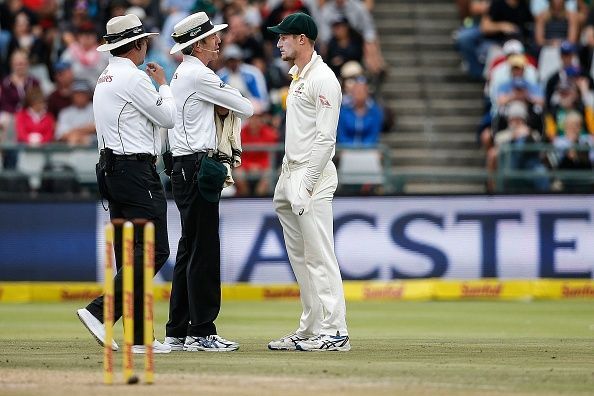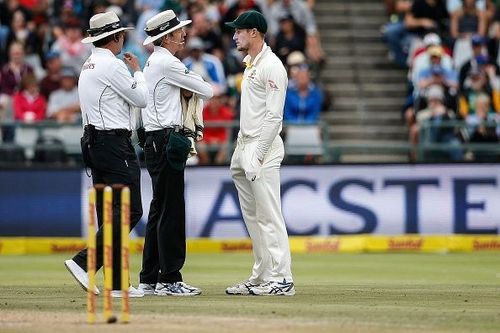
South Africa vs Australia, 3rd Test: Why the Sandpaper Gate is worse than you think

When the zoomed in shots of Cameron Bancroft’s lower body persistently flashed on the television screen, it is okay if you felt creeped out. Gradually, you must have understood what was really happening as shots of umpires questioning Bancroft surfaced since the cameraman had done a great job at making this a big deal.
A message had been conveyed to Bancroft by his coach Darren Lehmann and Bancroft’s poor execution of a well-thought plan was out for the world to see.
A cricket website on Twitter mentioned that it was a sunglass cleaning cloth and the very thought of putting a cleaning cloth inside his pants was disturbing. It was problematic for whatever purpose it was intended but when more visuals started to surface where Bancroft was seen using it to tamper with the ball, all hell broke loose, and rightly so.
'Everybody does it' is a weak argument
The counter-argument to the Brainfade 2.0 that 'all teams do it but only a few get caught' is a weak one. Just last year, the captain of the opposition team, Faf du Plessis was under the scanner for shining the ball with his mint-gum.
However, what changes the equation here is the fact that captain Steve Smith accepted that his team was involved in tampering the ball. What makes this worse is that this was a pre-planned strategy devised by the “leadership group” of the team.
The message that they are trying to convey is problematic on many levels because of the very fact that one of the top Test teams thought it was an acceptable tactic to follow without the fear of repercussions while breaking several ethical and moral codes.
The increasing tension off-the-field in the ongoing series where the spirit of cricket was in question makes it an absolutely disastrous time to do something that is so openly against the much talked about spirit.
Broadcaster’s role
On Day 2 of the ongoing Third Test, the broadcaster was criticized on social media for giving pertinent focus to Pat Cummins stepping on the ball. While that may have been accidental, the damage had been done as it went viral.
When the cameraman was adamant about showing to the world what also transpired on Day 3 in Bancroft’s case, little could be said about the broadcaster’s bias against the visiting side.
More so since the Australian press, often called the team’s 12th man, champions the Aussie cause mostly all the time, then the South African broadcasters are well within their right to do the same for their home side. This scandal, in fact, also raises questions on Australia’s protests against the stump mics.
The ethical problem
Apart from this issue violating the spirit of cricket in general, it also brings into the spotlight the need to be cautious about what you want your team to be associated with. In the last one year, Steve Smith and Co. have been caught with ethical breaches two times.
First, it was the entire DRS Gate against India where Virat Kohli went on to say that the concept of collective cheating was prevalent in the Aussie camp. He was called a liar and the issue was eventually brushed under the carpet. Interestingly, before Smith was caught for his “brain-fade”, his DRS calls were right 7 times out of 16. After he was caught, he got it right just once in 12.
Second, Cummins' stepping over the ball didn’t receive much attention because it did not look deliberate and may perhaps have been a genuine mistake, however, the latest transgression raises questions on that “mistake” too.
Most importantly, Australia as a cricketing nation is looked up to but their insistence on involving below-the-belt antics, unethical strategies and outright “mental disintegration” only harms their reputation as a whole.
Steve Smith, who is considered as the best Test batsman at the moment, admitting to approving cheating also slightly makes one wonder about his work ethic. Along with him, senior players like David Warner, Mitchell Starc, Josh Hazlewood and Pat Cummins are admired by several budding cricketers. What does their agreement and involvement in such strategies do to people who look at them as role-models?
Not on my watch, assures Smith
Smith and Bancroft were apologetic about the incident, as understood by their press conference. But, would they have admitted to it if there wasn’t conclusive evidence such as the footage of what Bancroft did? Would they have accepted the allegations if it did not create as big an outrage as it did? Would they have come out if they had no other option to?
Smith also said that coach Darren Lehmann and the coaching staff was unaware of it. However, it was Lehmann who sent the message to Bancroft via Peter Handscomb which eventually resulted in Bancroft doing a shoddy job of hiding the sand-paper a.k.a the yellow tape. It gets worse because when enquired by the umpires, Bancroft seemed to have lied about what he did. So, wasn’t the coach party to it?
Smith also said that this was the first time that they did something like this and it wouldn’t happen again under his leadership. It is important to note that Smith didn’t think it was a good idea to name the people in the “leadership group” who were the minds behind this strategy.
While it is commendable to see a captain take the responsibility himself and not throw his team-mates under the bus, it is hardly commendable that he is entitled enough to conceal these details and get away with it.
It also makes you wonder why Bancroft, who could’ve been dropped the next game and has had a brief career, was chosen for this task. It is as if it is being conveyed that if a player is risking ruining his career, it might as well be a less recognized player and not the rest, who are all players of reputation.